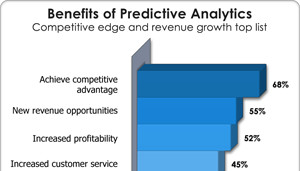
5 Predictions for Predictive Analytics in 2015
Below are my five prediction for the Predictive Analytics space for 2015. I would enjoy hearing your comments or thoughts
1. The continued adoption and growth of Hadoop and other Big Data technologies will drive greater adoption and utilization of Predictive Analytics across all industries.
2014 was the year that dis-spelled any remaining doubts about the mainstream adoption of Hadoop . The aggregation of big data in a single data store is rapidly increasing the capabilities of Data Science teams in the enterprise. In addition, the combination of cloud computing and open source options has lowered the cost of entry for start-ups with Big Data and Analytics vertical application plays driving exciting innovations.
2. Predictive Analytics will begin to incorporate real-time data as standard-operating procedure.
The continued adoption and improved capabilities of smartphones and a mobile app driven culture along with the emergence of the Internet of Things (IoT) is forcing all companies to put in place either near real-time or real time response systems for both B2B and B2C customers in order to remain competitive. Both traditional large technology platform vendors (such as IBM, Oracle, SAP, Teradata, Software AG, Tibco ) and open source alternatives (such as Databricks, DataTorrent, Cask, Confluent, and Storm) as well as the big cloud players (Amazon, Google and Microsoft) are offering near real time and real time data processing capabilities and seeing growing rates of adoption as these technologies become a requirement to stay competitive. There are also a number of venture capital backed startups offering additional proprietary solutions in this space.
3. Predictive Analytics will become a primary factor when companies consider either a continuing or initial investment in Big Data and Analytics projects.
There are a myriad number of reasons why companies invest in Big Data and Analytics initiatives Inevitably as these initiatives mature from POC to Pilot to Phase I Production and beyond; Predictive Analytics becomes one of the reasons to prioritize and increase investment in these projects. This is driven by the high ROI on Predictive Analytics initiatives and the ability to capitalize on the insights to launch new applications, products and services before competitors. (See the chart from Tony Cosentino of Ventana Research above this post).
4. Companies find significant economic value in improving how Data Scientists move Predictive Analytic models from development into production IT environments.
As more focus is placed on Predictive Analytics, companies will begin to become more aware that the current system of deploying sophisticated predictive analytic models through custom coding is expensive, slow and has massive opportunity costs. As this comes to the forefront, an open industry standard, the Predictive Model Markup Language (PMML) will continue to gain momentum as the way to solve this problem and several others related to the operationalizing of predictive analytic models.
5. Companies that not only build Data Science teams but integrate their work product seamlessly into IT and business processes gain a demonstrable strategic competitive advantage that reflects in financial results.
In a large enterprise, Predictive Model deployment is often an Information Technology (IT) project. IT projects typically take six months or more to complete within large enterprises. By leveraging PMML, companies can deploy their new or revised Predictive Analytic Models immediately. Which companies are going to win in the era of Big Data and Analytics? Companies that take advantage of contemporary technology to move faster to satisfy customer needs with higher quality and less cost or those relying on legacy models of doing business.
In addition, companies that use contemporary deployment models vastly improve the productivity of their Data Science team(s) which translate into material positive bottom line results.
......
Please like, share or comment on this post. If you would like a needs analysis of your predictive model development and deployment process or would like to discuss any of the ideas in this post - please reach out to me either via Linkedin or @bigrealtimedata on Twitter.
PMML is helping streamline the process of going from model development to production, but it only addresses a portion of the friction (eliminating the re-coding of models). There are still tremendous challenges related to data management and integration into the production systems that benefit from the prediction.
Head of Platform
9yNice post, Mark. I also think we'll start to see tremendous progress in cleansing data, as well as a broader recognition of the true definition of predictive analytics, rather than current confusion with reporting tools.
A Serial entrepreneur with a passion towards cutting edge technology
9yGreat thought Mark! It's interesting to learn about the evolution of PMML in the Open world.Look forward to see faster adaption of Predictive Analytics in the Mfg. and Healthcare industries.
CEO Founder @ Peer2Peer Partners | B.B.A., Digital Marketing and Conversion Rate Optimization Executive
9yData connectivity makes all this possible.
Instructor and curricula designer for Technologists and Developers
9yin 2015, 3D graphics will finally become anathema and they will no longer be used.